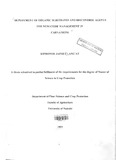| dc.description.abstract | Plant parasitic nematodes cause yieldreductions in ornamental crops of up to 11%, however, intensive use
of nematicides is being discouraged worldwide making environmental friendly management approaches a
necessity. Thus a study was carried out with the aim of developing environmentally sound approaches in
management of nematodes in carnati~ns. Various organic substrates namely sugarcane bagasse, tea and
flower composts, molasses, nematophagous fungus Paecilomyces lilacinus (PL plus"), neem (Achook"),
and the standard chemical nematicide fenamiphos (Nemacurf) and a control were evaluated against plant
parasitic nematodes and assessed their effect on non-target free-living nematodes and on overall nematode
biodiversity populations associated with carnation plants. The experiments were carried out under
greenhouse conditions using complete randomized design with six replications each. Soil samples were
collected before application/planting (0 DAP), 90 DAP and 180 DAP. Nematode diversity was determined
using the methods of Shannon-Wiener, abundance, richness, dominance, evenness and plant parasite
indices of diversity. At the start of the experiments, there were no significant differences in populations of
all nematodes. At 180 DAP out of the 16 genera of plant parasitic nematodes recovered only
Helicotylenchus, Criconema and Longidorus populations had not been depressed by all treatments. Galling
due to root-knot nematode was reduced by between 53 and 69% in treated plots compared to the control.
The most predominant plant parasitic nematodesirecovered at the end of the experiments were in the genera
Scutellonema, Helicotylenchus and Meloidogyne with percentage densities of 14.7, 13.6 and 11.6 %
respectively. Application of organic substrates namely bagasse, molasses, tea and flower composts resulted
in increased abundance of free-living nematodes compared to the control. Among the 14 genera of the freeliving
nematodes recovered, bacterial feeders accounted for 73% while fungal feeders and predators
accounted for 14% and 13% respectively. Members of the genus Rhabditis were predominant among the
bacterial feeding nematodes representing 10% of the nematodes while Mononchus (10%) and
Aphelenchoides (14%) dominated predacious and fungivorous trophic groups respectively. A significant
reduction in abundance of free-living nematodes was recorded in plots treated with fenamiphos and neem
except in the genera Cephalopus and with the highest counts recorded in the control plot (796) followed by
flower compost at 600 while the least was in plots treated with fenamiphos. In the genera richness, organic
substrates and Paecilomyces lilacinus recorded the highest while fenamiphos plots had the least. Nematode
diversity, according to Shannon-Weiner diversity index (H) at 180 DAP was 2.91, 2.98 and 2.95 in plots
treated with bagasse, tea and flower composts respectively, compared to 1.8 in plots treated with
fenamiphos. Dominance of nematodes was observed only in plots treated with fenamiphos and neem at 180
DAP. Evenness and Plant parasite indices were lowest before treatments were administered and increased
with time reaching a peak at 180 days. This study has established that application of organic substrates and
Paecilomyces lilacinus was suppressive to plant parasitic nematodes and also stimulated build-up of freeliving
nematodes. The products can be strongly recommended for use in sustainable carnation production
systems. | en |

